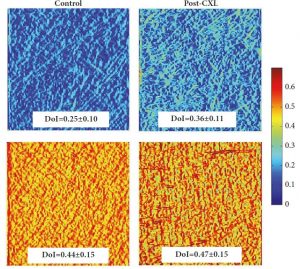Abstract
Corneal cross-linking (CXL) is a surgical procedure able to modify corneal biomechanics and stabilize keratoconus progression. Although it is known that CXL produces changes in corneal collagen distribution, these are still a topic of discussion. Here we quantitatively compare the corneal stroma architecture between two animal models four weeks after in vivo conventional CXL treatment, with second harmonic generation (SHG) imaging microscopy and the structure tensor (ST). The healing stage and the stroma recovery were also analyzed by means of histological sections. Results show that the CXL effects depend on the initial arrangement of the corneal collagen. While the treatment increases the order in corneas with a low level of initial organization, corneas presenting a fairly regular pattern are hardly affected. Histological samples showed active keratocytes in anterior and middle stroma, what means that the recovery is still in progress. The combination of SHG imaging and the ST is able to objectively discriminate the changes suffered by the collagen arrangement after the CXL treatment, whose effectiveness depends on the initial organization of the collagen fibers within the corneal stroma.


